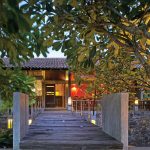-
Ulagalla Boutique Hotel
April 2011

An ancestral home redefined Bordering the Ulagalla and Wannanmaduwa reservoirs, in Anuradhapura, the Boutique Hotel at Ulagalla is built on 52 acres of sprawling land. Consisting of 20 luxurious chalets, scattered across lush greenery, Architect Nihal Amarasinghe and his team were determined to ensure that the hotel blends well with its natural environment. A unique design was adopted to capture the panoramic views across the woodlands and the lakes.
By: Madhushala Senaratne
The central feature of the hotel is an ancient walauwa dating from the British Colonial Period, which has been carefully restored and rehabilitated, maintaining most of its original design elements. At the entrance are a lotus pond and a carved moonstone replicating those of the Anuradhapura era. The renovated walauwa houses the hotel’s reception, sitting lounge, restaurant, coffee shop, bar, kitchen area and offices. An old cellar found beneath the floor of the walauwa was transformed into the storage space for the bar, while the restaurant is located in the attic area. The swimming pool of the hotel has been elaborately designed. The original courtyards have been retained with the enclosing walls removed, to seamlessly blend the indoors with the outdoors. Columns made of steel sections encased in timber, now act as the structural supports instead of the old walls. A design formed with timber planks is seen on the polished cement floor.
Speaking of the challenges he faced Archt Amarasinghe recalled how, the high embankments surrounding the reservoirs, obstructed the scenic views and the statutory regulations which required construction to be 100 metres away from a water body. The design approach of the chalets was evolved as a direct response to these restrictions, and the rich natural beauty of the surrounding landscape. Thus was created the elevated chalets, the unique feature of this boutique hotel. A total of eight mounds were built, using earth brought from outside. Rectangular in shape, they were ten feet high and sloped at 45 degrees. The chalets were then constructed on concrete pillars built on the mounds. Timber frames laid with boards made of compressed straw formed the floors of the structures. The client, the International Construction Consortium (ICC) had requested the use of this straw board in order to make the structures light.
The chalet roofs were made of a combination of welded steel and timber beams, the former having been well camouflaged to represent the latter in form. Described as “glass boxes,” floor-to-ceiling glass walls have been used around the chalets to capture the picturesque view. The low, wide eaves provide the necessary protection to the chalet structures from the natural elements, and help in minimising heat gain.
On each mound are two chalets, which are accessed by an earthen ramp. The main entrance to the chalet is located at its centre. Each chalet comprises of living and dressing areas, bedroom and bathroom, and is equipped with an individual plunge pool.
“The client wanted the hotel to be eco-friendly,” explained Archt Amarasinghe . He described the solar farm which provides the entire energy requirement of the hotel. The hotel has eco friendly recreational activities such as horse riding, nature walks and archery. The architects were also required to demarcate an area to be developed as an orchard.
Set away from the ancient capital city, the Boutique Hotel at Ulagalla has been designed to harmonise with the natural beauty of its surroundings, inviting its guests to not merely relax, but experience the rich landscape as well.
Photographs courtesy: ICC
Principal Architect: Nihal Amarasinghe
Total Area of Site: 52 acres
Total Floor area of Project: 6000 sq metres
Client: International Construction Consortium (ICC)

















